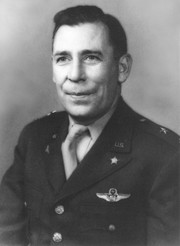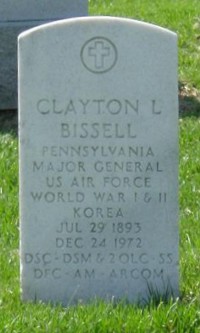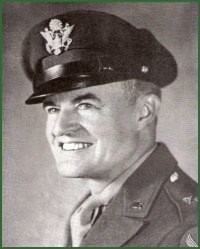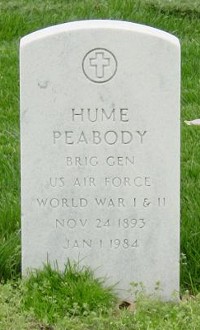
|
McKean County
& Vicinity
Highest Ranking Officers |
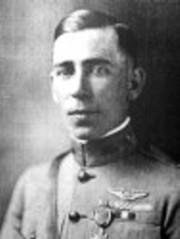 |
Major General Clayton L. Bissell Bissell graduated from Valparaiso University, Indiana, in 1917 with a degree of doctor of laws. He enlisted in the Aviation Section, Signal Reserve, August 15, 1917, and was commissioned a first lieutenant in the Aviation Section, Signal Reserve, January 12, 1918. He began his aviation training at Mohawk, Canada, in September 1917, and was subsequently stationed at Taliaferro Field, Texas, from November 1917 to January 1918. He sailed for England with the 22nd Aero Squadron, and received additional flying training at Salisbury Plain in England and aerial gunnery training in Scotland. He served in the Overseas Ferry Service before he was ordered to duty at the front with the 148th Aero Squadron in July 1918. He served with that unit and with the 41st Aero Squadron until the armistice. He was credited officially with destroying five enemy planes and driving one down out of control; these six victories qualify him as an "ACE." He commanded the 639th Aero Squadron with the American Forces in Germany until May 1919, when he returned to the United States. |
| His first assignment
in the United States was Kelly Field, Texas, where he organized
and commanded the 27th Aero Squadron. He was promoted to captain
(temporary) March 11, 1919. In January 1920, he became education
and recreation officer at Kelly Field, and commanded the Air Service
Group He was ordered to Washington, D.C., in June 1920, for service
as chief of the Tactical Operations Section in the office of Air
Service. He was commissioned a first lieutenant in the Air Service,
Regular Army, July 1, 1920. In December 1920, he went to Langley
Field, Virginia, where he graduated from the Air Service Field Officers
School in June 1921. He then remained at Langley Field as flight
commander of the 14th Bomb Squadron, and later became an instructor
in the Air Corps Tactical School In November 1921, he was ordered
to Washington for duty in the office of the Chief of the Air Service,
as assistant to Brigadier General William Mitchell, serving in that
capacity for four years. In January 1924, he was detailed as advanced agent for the round-the-world flight in British Columbia, Alaska, the Aleutians, Greenland, Labrador, Newfoundland and the Maritime Provinces. On return to Washington, he was transferred to Langley Field in December 1924 to serve as secretary of the Air Service Board. Between October and December 1925, he served as assistant defense counsel for Mitchell during his court martial, under the direction of lead counsel Congressman Frank R. Reid He was an instructor at the Air Corps Tactical School at Langley Field, from September 1926 to August 1931, when he was assigned to the Command and General Staff School at Fort Leavenworth, Kansas, as a student. He graduated in June 1933, and two months later was assigned to the Army War College at Washington, D.C. He graduated in June 1934 and then entered the Chemical Warfare School at Edgewood Arsenal, Maryland. In July 1934, completing the course there a month later In October 1934, he was stationed at Schofield Barracks, Hawaii, as intelligence and operations officer of the 18th Pursuit Group, becoming commanding officer in October 1937. In July 1938, he went to the Naval War College at Newport, Rhode Island, and graduated in 1939. In July 1939, he became a member of the War Plans Division of the War Department General Staff at Washington, remaining on this duty until the beginning of World War II. |
|
|
In January 1942, he was assigned as
principal aviation officer on Major General Stilwell's staff in
China; in August 1942 he was made commanding general of the 10th
Air Force in India and Burma. He returned to the United States
in August 1943 A month later he became assistant chief of air
staff for intelligence at Air Force Headquarters in Washington.
In January 1944, he was assigned to the Office of the Assistant
Chief of Staff for Intelligence on the War Department General
Staff, and served in that capacity during the last two years of
World War II. He was the Army member of Joint Security Control
and on the Joint Intelligence Committee and the U.S. Army member
of the Combined Intelligence Committee. He also served as the
Army head of psychological warfare and as head of the War Department
historical program. Buried: Section 5, Site 68, Arlington National Cemetery
|
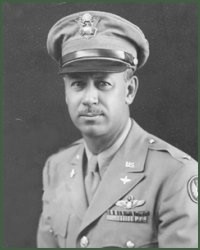 |
Major General Fay R. Upthegrove Born: Port Allegany, PA Upthegrove was raised in Rew and graduated from Bradford High School and later the U.S. Military Academy on June 14, 1927 and was commissioned a second lieutenant of Infantry. That fall General Upthegrove entered Primary Flying School at Brooks Field Texas and graduated from Advanced Flying School at Kelly Field, Texas in October 1928. He then became engineering officer of the 15th Observation Squadron at Selfridge Field, Mich., and in January 1929 was transferred to the Air Force. |
|
Entering the Chemical Warfare School
at Edgewood Arsenal, Md., a month later, he graduated that April
and returned to the 15th Observation Squadron. Moving to March
Field, Calif., in June 1930, General Upthegrove was an instructor
at the Primary Flying School. In October 1931 he was named supply
officer of the Primary Flying school at Randolph Field, Texas,
and the following March was appointed adjutant of the 47th School
Squadron there. Going to Luke Field, Hawaii, in November 1934,
General Upthegrove was named flight commander of the Fourth Observation
Squadron the following January and assumed command in August 1936.
Transferred to Mitchel Field, N.Y., he was assigned duty as operations
and intelligence officer of the 99th Bomb Squadron. Entering the
Air Corps Tactical School at Maxwell Field, Ala., in May 1939,
he graduated that August and returned to Mitchel Field as commander
of the 99th Bomb squadron. Buried: St. Bonaventure Cemetery, Allegany, NY |
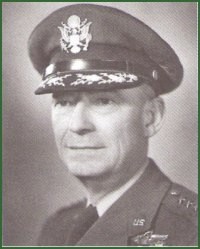 |
General Joseph T. McNarney Born: Emporium, PA Joseph Taggart McNarney graduated from the United States Military Academy in June 1915 (as part of "the class the stars fell on") and was commissioned a second lieutenant of Infantry. McNarney served with the 21st Infantry at Vancouver Barracks, Washington, and with the 37th Infantry at Yuma, Arizona. In July 1916 he became a first lieutenant and began flight training at San Diego, California. One year later he was rated a junior military aviator and transferred to the Signal Corps Aviation Section. He became an instructor in meteorology and radio telegraphy and was promoted to captain in May 1917. |
|
McNarney went to France in 1917 and
became an assistant to the 1st Corps Aeronautical School. He joined
Headquarters Air Service in January 1918. McNarney helped direct
the 2d Corps School and led flights of the 1st Aero Squadron in
the Toul sector. He was promoted to major in June 1918. During
the Chateau Thierry offensive he was commanding officer of the
1st Corps Observation Group, chief of Air Service of the 3d Corps,
and on the staff of the chief of Air Service of the 1st Army.
He commanded the Air Corps during the St. Mihiel offensive and
the 5th Corps during the Meuse-Argonne Offensive. In February
1919 he became commanding officer of the 2d Army's Observation
Group and was promoted to lieutenant colonel in May 1919. While
on duty at American Expeditionary Force Headquarters he Paris,
McNarney wrote a manual on air observation. Buried: Forest Lawn Memorial Park, Glendale, CA |
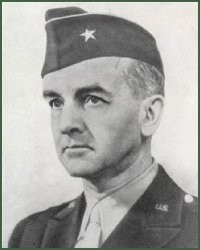 |
Brigadier General Ronald C. Brock Born: Coudersport, PA 1940 - 1943 Commanding Officer 106th
Field Artillery Regiment Buried: Williamsville Cemetery, Williamsville, NY |
|
|
Brigadier General Hume Peabody Born: Shinglehouse, PA Following graduation from the U.S. Military
Academy, West Point, N.Y., he was appointed a second lieutenant
of Cavalry on June 12, 1915. He first was assigned to the 3rd
Cavalry at Brownsville, Texas, on border patrol duty. He had a
skirmish with bandits at Tahuachal, and at Villa Verd Ranges,
Mexico, in June 1916. He was stationed at Brownsville until March
1917, then moved to Fort Sam Houston, Texas, where he remained
until 1917. He was detailed in the Flying School, San Diego, Calif.,
thereafter until December 1917, and following graduation remained
on duty at that station until February 1918. Buried: Arlington National Cemetery |
